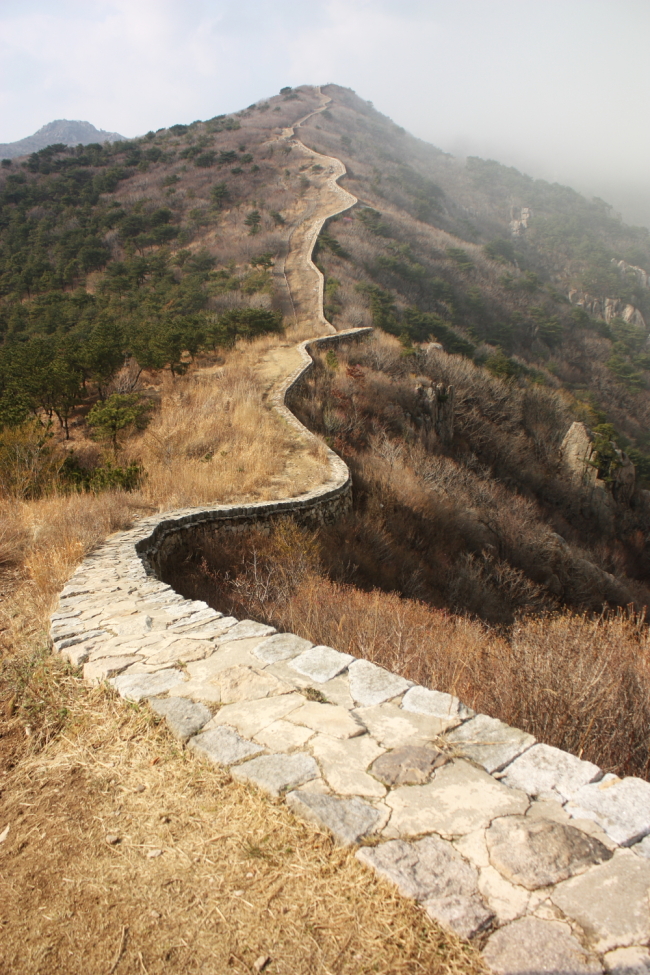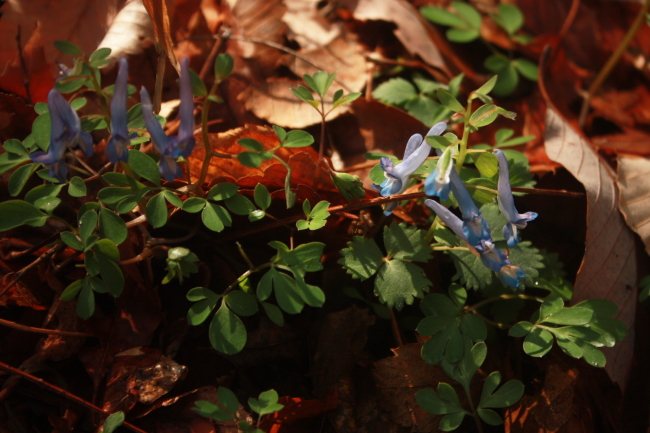Clouds drift past and reveal a stone wall that juts forward then curls back and forth, like an eel until it reaches the minor summit of Wonhyobong. Beyond the peak a new section of the wall is revealed, then another, until it begins to seem that the Mount Geumjeongsan fortress in north Busan has an inexhaustible supply of striking views.
Eventually, though, one comes full circle. At 18 kilometers in length, it is the longest such wall in Korea, and like Namhansanseong Fortress south of Seoul, it outlines a jagged oval. But Geumjeongsan Fortress is about 1.5 times longer than its northern counterpart, with four gates and four watchtowers to tick off on the map. Geumjeongbong Peak, the highest summit, is only 802 meters above sea level, making it an easy romp for young and old.
 |
Geumjeong Fortress winds northward to Uisangbong, one of Mount Geumjeongsan’s many peaks.(Matthew Crawford/The Korea Herald) |
On the last Saturday of March, cherry blossoms were in bloom on every thoroughfare of the city, but the heat of the previous day had summoned up a steady downpour. The mountain was completely obscured by rain clouds until Sunday afternoon, when Busan’s hiking crowd began to venture onto the trails.
From Namsan Station, a short walk led to a gathering of exercise machines in the forest, then to small plots under cultivation by urban farmers. Rising up from the very base of the slopes was a set of tan-colored brick towers, the new campus of Busan University of Foreign Studies.
 |
Corydalis, used in oriental medicine as a painkiller,sprouts from the leaves along a path on Mount Geumjeongsan, Busan. (Matthew Crawford/The Korea Herald) |
An untraveled side trail along a stream showed evidence of spring on all sides ― clumps of grass pushing aside last year’s leaves, tiny green crescents poking out from the branches, azaleas blooming among the boulders and small flowers unfolding on the path. These included white and yellow violets, and tubular, violet corydalis.
It took about an hour to reach the ridge and the fortress wall, most of which was restored between 1972 and ’89. The history of the bulwark is misty, as there were various constructions, reconstructions and repairs over the years, perhaps extending as far back as the Silla Kingdom.
The ridge affords views of the winding Nakdonggang River to the west, the Hoedong Reservoir to the east and, on clear days, the Korea Strait. What made Busan a refuge during the Korean War ― its location at the southeast extremity of the peninsula ― made it a target for Japanese attacks in earlier eras, hence the scale of Mount Geumjeongsan’s defenses.
On the Sunday in question, though, two groups of rock climbers were making short work of the all-natural stone citadel of Buchaebawi Rock, outlined like ants along the stacked, bus-sized blocks and evidently a source of amusement for the crows.
Less daring but just as assiduous were the women who had ducked under the off-limits rope to dig up mugwort from the grass. One herb collector was prying up specimens while her husband took a nap on the wall itself, at rest under a troubled sky.
Further north, near Wonhyobong Peak, a signboard notes, “According to local legend, General Kim Yu-sin of the Silla Dynasty stood at attention for a long time and urinated near this peak when he was training his soldiers.” After the general relieved himself, one of his loyal soldiers planted a pine tree on the very spot, and it thrived for many years. The tree’s exact location, if it still stands, is no longer known.
Moving on to the North Gate, and then down to the “Sea of Rocks,” the excursion drew to a close at Beomeosa, a center for Seon (or Zen) Buddhism and the most famous of Mount Geumjeongsan’s temples. The complex had plum, cherry and magnolia trees in bloom and, in the perennial category, boulders covered in scripture and some of the tallest pines left standing in Korea.
Visitors to Beomeosa are asked to behave respectfully ― there is a ban on “camping, partying or playing” in the valley. Those who are curious about Korean Buddhism can participate in Beomeosa’s templestay program. For more information and reservations, visit the Jogye Order’s templestay website at eng.templestay.com.
Getting there:
Mount Geumjeongsan can be reached on foot or by bus from the northern part of Busan Metro’s Line 1. Nopo Station, the end of the line, connects with Busan Central Bus Terminal. From Beomeosa Station, one stop south, bus 90 covers the short distance to Beomeosa Temple. Namsan, Dusil, Guseo, Jangjeon and Busan National University stations provide access to lesser-traveled paths.
At the southern end, Oncheonjang Station is close to a cable car, for those who want a view without the exertion of hiking. Hot spring facilities in the area include the spacious Hurshimchung Spa in Hotel Nongshim. Note that a road extends from the East to the West gates of the fortress, passing through a village in the middle, and that access is also possible from Line 2, on the west side of Mount Geumjeongsan.
By Matthew C. Crawford (
mattcrawford@heraldcorp.com)









